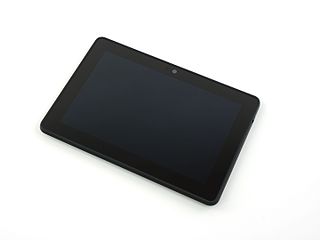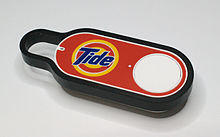
A barcode reader or barcode scanner is an optical scanner that can read printed barcodes, decode the data contained in the barcode on a computer. Like a flatbed scanner, it consists of a light source, a lens, and a light sensor for translating optical impulses into electrical signals. Additionally, nearly all barcode readers contain decoder circuitry that can analyse the barcode's image data provided by the sensor and send the barcode's content to the scanner's output port.

The CueCat, styled :CueCat with a leading colon, is a cat-shaped handheld barcode reader that was given away free to Internet users starting in 2000 by the now-defunct Digital Convergence Corporation.

A hotspot is a physical location where people can obtain Internet access, typically using Wi-Fi technology, via a wireless local-area network (WLAN) using a router connected to an Internet service provider.
A universal remote is a remote control that can be programmed to operate various brands of one or more types of consumer electronics devices. Low-end universal remotes can only control a set number of devices determined by their manufacturer, while mid- and high-end universal remotes allow the user to program in new control codes to the remote. Many remotes sold with various electronics include universal remote capabilities for other types of devices, which allows the remote to control other devices beyond the device it came with. For example, a VCR remote may be programmed to operate various brands of televisions.

The Nintendo Wi-Fi USB Connector is a wireless game adapter, developed by Nintendo and Buffalo Technology, which allows the Nintendo DS, Wii and 3DS users without a Wi-Fi connection or compatible Wi-Fi network to establish an Internet connection via a broadband-connected PC. When inserted into the host PC's USB port, the connector functions with the Nintendo DS, Wii, DSi and 3DS, permitting the user to connect to the Internet and play Nintendo games that require a Wi-Fi connection and access various other online services. According to the official Nintendo website, this product was the best-selling Nintendo accessory to date on 15 November 2007, but was discontinued in the same month. On September 9, 2005, Nintendo announced the Nintendo Wi-Fi Network Adapter, an 802.11g wireless router/bridge which serves a similar purpose.

Wi-Fi Protected Setup (WPS) originally, Wi-Fi Simple Config, is a network security standard to create a secure wireless home network.

Eye-Fi was a company based in Mountain View, California, that produced SD memory cards with Wi-Fi capabilities. Using an Eye-Fi card inside a digital camera, one could wirelessly and automatically upload digital photos to a local computer or a mobile device such as a smartphone or tablet computer. The company ceased business in 2016.
Amazon Kindle is a series of e-readers designed and marketed by Amazon. Amazon Kindle devices enable users to browse, buy, download, and read e-books, newspapers, magazines and other digital media via wireless networking to the Kindle Store. The hardware platform, which Amazon subsidiary Lab126 developed, began as a single device in 2007. Currently, it comprises a range of devices, including e-readers with E Ink electronic paper displays and Kindle applications on all major computing platforms. All Kindle devices integrate with Windows and macOS file systems and Kindle Store content and, as of March 2018, the store had over six million e-books available in the United States.

The Dash was a device manufactured by Sony that connected using Wi-Fi to the Internet. It had a touch screen which the user could use to browse information or listen to music. It was not a portable device since it did not have an internal battery. It was positioned as a personal internet viewer which could act as an alarm clock, Internet radio, digital photo frame and many other uses. It had applications which were downloaded onto the device. These were the same as those supported by the Chumby device.
Inventory management software is a software system for tracking inventory levels, orders, sales and deliveries. It can also be used in the manufacturing industry to create a work order, bill of materials and other production-related documents. Companies use inventory management software to avoid product overstock and outages. It is a tool for organizing inventory data that before was generally stored in hard-copy form or in spreadsheets.
IEEE 1905.1 is an IEEE standard which defines a network enabler for home networking supporting both wireless and wireline technologies: IEEE 802.11, IEEE 1901 power-line networking, IEEE 802.3 Ethernet and Multimedia over Coax (MoCA).

ecobee is a Canadian founded home automation company that makes smart thermostats, temperature and occupancy sensors, smart light switches, smart cameras, and contact sensors. They were acquired by the American company Generac Holdings in 2021.

The Fire HDX, formerly named Kindle Fire HDX, was a high-end model in Amazon Fire line of tablet computers. It was announced on September 25, 2013, and was available in two models, 7 inch and 8.9 inch. The 7 inch WiFi model was released on October 18, 2013, and the 8.9 inch WiFi model was released on November 7, 2013, in the United States.

LIFX is a line of energy-efficient, multi-color, Wi-Fi enabled, digital addressable LED light bulbs that can be controlled via a Wi-Fi equipped device such as a smartphone or smartwatch.

Amazon Fire TV is a line of digital media players and microconsoles developed by Amazon. The devices are small network appliances that deliver digital audio and video content streamed via the Internet to a connected high-definition television. They also allow users to access local content and to play video games with the included remote control or another game controller, or by using a mobile app remote control on another device.
Amazon Echo, often shortened to Echo, is an American brand of smart speakers developed by Amazon. Echo devices connect to the voice-controlled intelligent personal assistant service Alexa, which will respond when a user says "Alexa". Users may change this wake word to "Amazon", "Echo", "Computer", and other options. The features of the device include voice interaction, music playback, making to-do lists, setting alarms, streaming podcasts, and playing audiobooks, in addition to providing weather, traffic and other real-time information. It can also control several smart devices, acting as a home automation hub.
Amazon Alexa or Alexa is a virtual assistant technology largely based on a Polish speech synthesizer named Ivona, bought by Amazon in 2013. It was first used in the Amazon Echo smart speaker and the Echo Dot, Echo Studio and Amazon Tap speakers developed by Amazon Lab126. It is capable of natural language processing (NLP) for tasks such as voice interaction, music playback, creating to-do lists, setting alarms, streaming podcasts, playing audiobooks, providing weather, traffic, sports, other real-time information and news. Alexa can also control several smart devices as a home automation system. Alexa capabilities may be extended by installing "skills" such as weather programs and audio features. It performs these tasks using automatic speech recognition, NLP, and other forms of weak AI.
Virtual assistants are software technology that assist users complete various tasks. Well known virtual assistants include Amazon Alexa, and Siri, produced by Apple. Other companies, such as Google and Microsoft, also have virtual assistants. There are privacy issues concerning what information can go to the third party corporations that operate virtual assistants and how this data can potentially be used.

The Netflix button is a button available on many modern remote controllers, used to directly connect to the popular streaming service Netflix. It was initially implemented in America in 2011. In 2015, the button was added to European remotes. This button sends an infrared (IR) signal to the television and opens up the Netflix app. Many popular TV companies have adopted the Netflix button, including: LG, Samsung, Sony, and Hisense. Some of the TVs have made it to a list that Netflix has dubbed the "Netflix Recommended TVs". These are TVs that have a Netflix button on them which Netflix recommends to their subscribers to get the best viewing experience for their service. Some low-end laptop computers in emerging markets also ship with streaming buttons, typically including Netflix. Brazilian OEM Positivo has been including Netflix keys on their laptops since 2018.

Amazon Luna is a cloud gaming platform developed and operated by Amazon. Available only in the United States, United Kingdom, Canada, Germany, France, Italy, and Spain, the platform is powered by Amazon Web Services, has integration with Twitch, and is available on Windows, Mac, Amazon Fire TV, iOS as well as Android. Luna offers access to a selection of games via the Luna+ subscription as well as to channels from brands such as Ubisoft+ and Jackbox Games.














